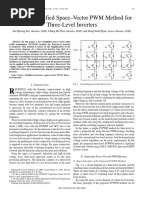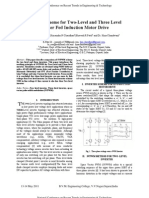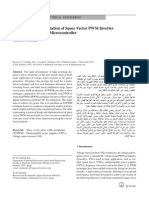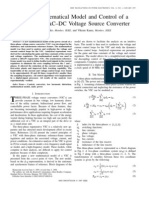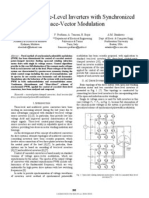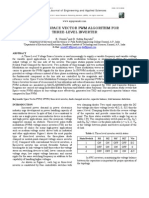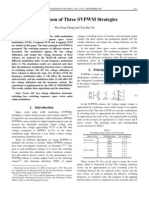PWM Rectifier
Uploaded by
sasikalasivakumarPWM Rectifier
Uploaded by
sasikalasivakumarIEEE TRANSACTIONS ON POWER ELECTRONICS, VOL. 22, NO.
6, NOVEMBER 2007
2245
Space Vector Modulation Applied to
Three-Phase Three-Switch Two-Level
Unidirectional PWM Rectifier
Flabio Alberto Bardemaker Batista and Ivo Barbi, Senior Member, IEEE
AbstractThis work presents a methodology to apply space
vector modulation to a three-phase three-switch two-level Y-connected unidirectional pulsewidth modulation (PWM) rectifier.
Converter switching stages are analyzed to determine switch
control signals for space vector modulation. A switching sequence
is proposed in order to minimize the number of switch commutations and to reduce the switching losses. Duty cycle functions are
determined and the desired switching sequences are performed
by a simple PWM modulator with no need of to determine the
present sector of vector. For this propose is just necessary to
impose the desired current sectors from input voltage references.
The vector control structure used with the proposed modulation
technique is also described. In order to validate the proposed
modulation technique, experimental results are presented for a
20 kW prototype.
Index TermsPower factor correction (PFC), space-vector modulation, three-phase acdc converters, unidirectional rectifiers.
NOMENCLATURE
A, B, and C
M, P, and N
,
, and
and
Phase designation.
Points of connection.
Switches for phases A, B, and C.
Switching period.
Transformation matrices.
Unit vector for axis
,
,
, and
Duty cycles for phases A, B, and C.
Currents for direct axis and quadrature axis.
Duty cycles for direct axis and quadrature
axis.
Space vectors.
,
,
,
and for axis .
, and
Application interval of vectors.
Duty cycles for axis and .
Projection of the application interval of
vectors in axis and .
Manuscript received April 20, 2006; revised September 25, 2006. Recommended for publication by Associate Editor M. Ferdowsi.
F. A. B. Batista is with the Federal Center of Technological Education of
Santa Catarina, CEFET/SCSanta Catarina, Brazil (e-mail: flabio@inep.ufsc.
br).
I. Barbi is with the Federal University of Santa CatarinaCEFET/SC, Santa
Catarina, Brazil.
Digital Object Identifier 10.1109/TPEL.2007.909184
Desired vector.
Source voltage.
Fundamental component of rectifier voltage.
Phase shift.
I. INTRODUCTION
HEN bidirectional power flux is not necessary, high
power factor unidirectional rectifiers present some
advantages as the decrease of the number of power switches,
natural protection of short-through and smaller processing of
energy for the active switches [1][3].
If output voltage is not so high, two-level topologies become
attractive because they do not need to control midpoint voltage of
the dc bus, reducing the number of sensors and controllers [4].
In this work, space vector modulation will be applied to a
three-phase three-switch two-level Y-connected unidirectional
pulsewidth modulation (PWM) rectifier [5] in order to minimize
the number of switch commutations as well as reduce converter
losses.
This structure presents as main drawback a high number of
semiconductors when compared with other topologies [1], [3].
Other characteristics of this topology are presented in [5].
The proposed application methodology of this modulation
technique is based on sub-sectors definition, on rectifier operation stages analysis and on duty cycles determination. Therefore, it is not necessary to identify the present vector sector, just
impose adequate current sector in phase with line voltages [6].
Section II presents the main characteristics of a two-level
unidirectional PWM rectifier and in Section III the basic steps
are described in order to apply space vector modulation to this
converter.
Vector control concepts used with the proposed modulation
techniques are shown in Section IV. In Section V experimental
results are presented and in Section VI conclusions and analysis
results are discussed.
II. THREE-PHASE THREE-SWITCH TWO-LEVEL
UNIDIRECTIONAL PWM RECTIFIER
The three-phase three-switch two-level Y-connected unidirectional PWM rectifier, showed in Fig. 1, presents high power
factor and output voltage regulation. Eight topological stages
may be performed from switches states, according to Table I.
This structure presents six symmetrical operation intervals
,
[5], where six current sectors are defined in one line period:
,
,
,
and
, as shown in Fig. 2. Each sector has
0885-8993/$25.00 2007 IEEE
2246
IEEE TRANSACTIONS ON POWER ELECTRONICS, VOL. 22, NO. 6, NOVEMBER 2007
TABLE II
AVAILABLE VECTORS
Fig. 1. Three-phase three-switch two-level unidirectional PWM rectifier.
TABLE I
SWITCHING STAGES
Fig. 3. Space vector coordinates.
null vector represents the situation where the three points are
connected.
In this notation, used for unidirectional converters, the available vectors representation does not agree with the switching
states because the potentials of points A, B and C depend on
the input currents direction. By the application of Clark transformation (1) space vector representation is made with a regular
hexagon divided in six vectors sectors, where vector coordinates
are determined as shown in Fig. 3
(1)
Fig. 2. Current sectors.
an interval of 60 and it is defined by the current that has the
greater value and its respective signal.
, can
Specific sector analysis, described below for sector
be extended for each other sectors considering the adaptation of
the direction of input currents.
(where phase A current is positive with higher
In sector
value) five equivalent topological stages are verified in stages 4,
5, 6, 7 and 8 of Table I.
When current is flowing from one phase to another, without
circulate in the load, two switches must be turned on and in order
to obtain null line voltages all three switches should be turned on.
III. SPACE VECTOR MODULATION
From the analysis of structure showed in Fig. 1, seven available vectors are defined as shown in Table II. Nonnull vectors
are represented by the potential of points A, B, and C, and the
In order to implement a desired vector
[Fig. 4], nonnull
vectors are averaged in the switching period. Sector 1 has the
following relationship:
(2)
The application intervals of vectors are calculated using the
projection of desired vector in the axis and in the axis as
represented in Fig. 4, resulting in
(3)
(4)
BATISTA AND BARBI: SPACE VECTOR MODULATION
2247
Fig. 6. Sub-sectors definition.
Fig. 4. Space vector representation.
Fig. 5. Relationship between input voltages and rectifier fundamental voltage
component.
Null vector application interval is calculated as
(5)
For unidirectional rectifiers, the definition of the sectors is
a little different from the traditional way [7], [8]. In this case,
available vectors implementation considers phase currents
direction.
Supposing that the currents are in phase with the respective
voltages, each phase presents an equivalent circuit with the
relationship between input voltages and rectifier fundamental
voltage component showed in Fig. 5.
Sub-sectors are defined from the intersection of vector sectors
and current sectors, as shown in Fig. 6. Therefore, space vector
representation is made in one diagram divided in these sub-sectors as shown in Fig. 7, where each current sector is divided in
two sub-sectors and presents four available vectors.
, the sub-sector SS1A and the sub-sector
For the sector
SS1C are considered. In sub-sector SS1A, the higher current
,
is in phase A and this current is positive and vectors
and
are used. For these current signals, space vector
is
performed in the operation stage of Fig. 8(a) and space vector
is performed in the operation stage of Fig. 8(b).
However, in sub-sector SS1C, the higher current is in phase C
and this current is negative and used vectors are the same as the
,
and
. Therefore, space vector
previous case:
Fig. 7. Space vector representation with sub-sectors definition.
is performed in the operation stage of Fig. 9(a) and space vector
is performed in the operation stage of Fig. 9(b).
In both sectors, in order to implement the null vector, it is
necessary that the three switches be turned on. The logic for determine the command signals considers that the switch in the
arm which processes the higher current be turned on in the respective current sector interval, so the proposed control signals
for implementing these vectors are shown in Table III.
The general rule for the representation of vectors is: to get the
one value in the desired vector, the switch in the correspondent
phase is turned on when the current with greater value is positive
,
and
) and the switch is turned off when this
(sectors
,
and
).
current is negative (sectors
To get the zero value in the vector, this logic is inverted. These
rules may not be applied to null vector.
The main objective of the logic of distribution of the command signals is the minimization of the number of commutations of the switches and reduction of the switching losses of the
2248
Fig. 8. Operation stages in sub-sector SS1A: (a) vector
IEEE TRANSACTIONS ON POWER ELECTRONICS, VOL. 22, NO. 6, NOVEMBER 2007
0!
V
and (b) vector
0!
V .
converter. However, the selected switching pattern was chosen
so that, in three phases, the level of the control signal is the same
(on) at the beginning and at the end of the switching period.
For sub-sector SS1A, the proposed vectors sequence
, resulting in the drive signals in Fig. 10.
is
Therefore, the intervals for the commands of switches are
Fig. 9. Operation stages in sub-sector SS1C: (a) vector
0!
V .
V , (b) vector 0!
TABLE III
CONTROL SIGNALS FOR SUB-SECTORS SS1A AND SS1C
(6)
Using the projections of the vectors in the axes and for the
respective sectors, the three-phase duty cycles are determined in
and
duty cycles
function of
(9)
(7)
For sub-sector SS1C, the proposed vector sequence is
, resulting in the drive signals for Fig. 11.
In this case, the intervals for the commands of switches and the
three-phase duty cycles are
(8)
Using the same methodology for all sub-sectors, one can determine the duty cycles as in Table IV. Applying the inverse of
and
duty cycles are calculated
Park transformation (10),
as
(10)
(11)
Extending this analysis to the other sectors, the duty cycle
functions for each switch are defined as shown in Fig. 12. In
is presented for
this picture, the duty cycle for switch
and
.
BATISTA AND BARBI: SPACE VECTOR MODULATION
2249
TABLE IV
DUTY CYCLES FOR ALL SUB-SECTORS
Fig. 10. Drive signals for sub-sector SS1A.
Fig. 11. Drive signals for sub-sector SS1C.
In the analysis of duty cycle equations of Table IV, one can
verify that the expressions for neighboring sub-sectors are equal
in the same current sector. Therefore, it is not necessary to identify the sectors of vectors; only to impose desired current sectors
from input voltages. The switches control signals to implement
the desired vectors are performed by a simple PWM modulator,
through the comparison of duty cycle functions with a triangular
waveform.
IV. VECTOR CONTROL
Vector control structure is shown in Fig. 13. In the control
system, input currents are sampled, Clark and Park transfor-
Fig. 12. Duty cycle for switch S .
mations are applied to these variables and dq0 currents are
obtained.
For a system with high power factor, the q axis current must
be zero. Therefore, the reference for the controller of this current
is also zero and the reference for d axis current comes from the
voltage controller.
The outputs of current controllers are the duty cycles for d
axis and for q-axis. These duty cycles are decoupled [9] and in-
2250
IEEE TRANSACTIONS ON POWER ELECTRONICS, VOL. 22, NO. 6, NOVEMBER 2007
TABLE V
SPECIFICATIONS USED IN EXPERIMENTATION
Fig. 14. Laboratory setup.
Fig. 13. Vector control structure.
verse Park transformation is applied to these variables. The duty
cycles for axis and for axis are the result of this transformation, and these signals are used in space vector modulation.
In digital control of the PWM rectifier, the TMS320LF2407A
DSP is used. For current loops, the sample rate is the switching
frequency and for voltage loop, the sample rate is the line
frequency.
V. EXPERIMENTAL RESULTS
Power parameters used in experimental verification are
shown in Table V. An example of design procedure is presented
in [5].
The laboratory setup for a 20 kW PWM rectifier is presented
in Fig. 14.
The selected components of the converter are as follows.
and : SKM50GAL120.
1) Switches ,
,
and
: SKM50GAL120.
2) Diodes
,
and
: HFA30PB120.
3) Diodes
:
4) Output Capacitor
.
,
and
: 2.4 mH/40 A.
5) Input Inductors
Drive signals for sub-sector SS1A are in Fig. 15 and drive
signals for sub-sector SS1C are in Fig. 16.
These signals are according to proposed signals shown in
Fig. 10 and Fig. 11.
Fig. 15. Drive signals for sub-sector SS1A (2 V/div).
Duty cycles for three switches, with format similar to theoretical duty cycles are presented in Fig. 17.
The input currents in the unidirectional PWM rectifier are
presented in Fig. 18, where it should be observed that they
.
present a low current distortion
The input current in phase A and the voltage reference for
phase A are presented simultaneously in Fig. 19. In this case,
the system presents a high power factor (0.998).
Fig. 20 shows the THD for rectifier input currents as function
of output power.
The rectifier power factor as function of the output power
is shown in Fig. 21. In this case, the measured total harmonic
distortion of the input voltage is 2.83%.
BATISTA AND BARBI: SPACE VECTOR MODULATION
Fig. 16. Drive signals for sub-sector SS1C (2 V/div).
2251
Fig. 19. Input voltage reference and current in phase A.
Fig. 20. THD for input currents as function of output power ( experimental
measurements).
Fig. 17. Duty cycles for switches A, B and C (5 V/div).
Fig. 21. Power factor as function of output power (
measurements).
Fig. 18. Input line currents (20 A/div).
experimental
The rectifier efficiency as function of output power is presented in Fig. 22. The rectifier efficiency is greater than 95%
when it is operating above one half of nominal load.
2252
IEEE TRANSACTIONS ON POWER ELECTRONICS, VOL. 22, NO. 6, NOVEMBER 2007
Fig. 22. Rectifier efficiency as function of output power (
measurements).
experimental
VI. CONCLUSION
A methodology to apply space vector modulation technique
was proposed to three-phase three-switch two-level unidirectional PWM rectifier. This methodology is summarized as
follows.
Identification of current sectors and vector sectors and definition of sub-sectors.
Analysis of topological stages of converter and verification
of available vectors in each sub-sector.
Definition of more adequate logic for disposing the command signals and vectors sequence.
Determination of intervals for application of vectors and
calculus of duty cycles functions in sub-sectors.
Implementation of command signals from PWM
modulator.
With this methodology, it is not necessary to determine the
sectors of vectors, only to impose desired current sectors from
input voltage references and the proposed methodology could
be applied to other two-level unidirectional PWM rectifiers
[10], [11]. The proposed modulation technique reduces the
number of commutations of switches and the switching losses
are minimized.
The vector control structure was described for an implementation with DSP controller and experimental results validate
the implemented modulation technique and the applied control
strategy. Unidirectional two-level PWM rectifier presents regulated output voltage, high efficiency, high power factor, and
low input current THD.
REFERENCES
[1] J. W. Kolar and H. Ertl, Status of the techniques of three-phase
rectifier systems with low effects on the mains, in Proc. 21st Int.
Telecommun. Energy Conference, INTELEC 99, Jun. 69, 1999.
[2] J. W. Kolar and F. C. Zach, A novel three-phase utility interface minimizing line current harmonics of high-power telecommunications rectifier modules, IEEE Trans. Ind. Electron., vol. 44, pp. 456467, Aug.
1997.
[3] B. Singh et al., A review of three-phase improved power quality
AC-DC converters, IEEE Trans. Ind. Electron., vol. 51, no. 3, pp.
641660, Jun. 2004.
[4] J. W. Kolar, U. Drofenik, and F. C. Zach, Space vector based analysis
of the variation and control of the neutral point potential of hysteresis
current controlled three-phase/switch/level PWM rectifier systems, in
Proc. Int. Conf. Power Electron. Drive Syst., Feb. 2124, 1995, vol. 1,
pp. 2233.
[5] D. Borgonovo, Y. R. Novaes, and I. Barbi, A three-phase three-switch
two-level PWM rectifier, in Proc. 34th Annu. IEEE Power Electron.
Specialists Conf., 2003, pp. 10751079.
[6] T. Viitanen and H. Tuusa, Experimental results of vector controlled
and vector modulated VIENNA I rectifier, in Rec. 35th IEEE Power
Electron. Specialists Conf., Jun. 2526, 2004, vol. 6, pp. 46374643.
[7] J. W. Kolar and J. W. Droferuk, A new switching loss reduced discontinuous PWM scheme for a unidirectional three-phase/switch/level
boost-type PWM (VIENNA) rectifier, in Proc. 21st Int. Telecommun.
Energy Conference, INTELEC 99, Jun. 69, 1999.
[8] H. W. Van Der Broeck, H. Skudelny, and G. V. Stanke, Analysis and
realization of a pulsewidth modulator based on voltage space vectors,
IEEE Trans. Ind. Applicat., vol. 24, pp. 142150, 1988.
[9] M. Cichowlas and M. P. Kamierkowski, Comparison of current control techniques for PWM rectifiers, in Proc. 2002 IEEE Int. Symp. Ind.
Electron., LAquila, Italy, Jul. 811, 2002, vol. 4, pp. 12591263.
[10] R.-J. Tu and C.-L. Chen, A new space-vector-modulated control for
a unidirectional three-phase switch-mode rectifier, IEEE Trans. Ind.
Electron., vol. 45, no. 2, pp. 256262, Apr. 1998.
[11] W. Koczara and P. Bialoskorki, Unity power factor three-phase rectifiers, in Proc. 24th Annu. IEEE Power Electron. Specialists Conf.,
Jun. 2024, 1993, pp. 669674.
Flabio Alberto Bardemaker Batista was born in
Alegrete, Rio Grande do Sul, Brazil, in 1971. He
received the B.S. degree in electrical engineering
from the Federal University of Santa Maria, Santa
Maria, Brazil, in 1995 and the M.S. and the Ph.D.
degrees in electrical engineering from Federal
University of Santa Catarina, Florianopolis, Brazil,
in 1996 and 2006, respectively.
Currently, he is Professor of the Federal Center
of Technological Education of Santa Catarina. His
research interests include power factor correction
and digital control.
Ivo Barbi (M76SM90) was born in Gaspar,
Santa Catarina, Brazil, in 1949. He received the
B.S. and M.S. degrees in electrical engineering from
Federal University of Santa Catarina, Florianpolis,
Brazil, in 1973 and 1976, respectively, and the Ph.D.
degree from the Institut National Polytechnique de
Toulouse, France, in 1979.
He founded the Brazilian Power Electronics
Society and the Power Electronics Institute of the
Federal University of Santa Catarina. Currently he
is Professor of the Power Electronics Institute of the
Federal University of Santa Catarina.
You might also like
- Hourglass Workout Program by Luisagiuliet 276% (21)Hourglass Workout Program by Luisagiuliet 251 pages
- The Hold Me Tight Workbook - Dr. Sue Johnson100% (16)The Hold Me Tight Workbook - Dr. Sue Johnson187 pages
- Read People Like A Book by Patrick King-Edited62% (65)Read People Like A Book by Patrick King-Edited12 pages
- Livingood, Blake - Livingood Daily Your 21-Day Guide To Experience Real Health77% (13)Livingood, Blake - Livingood Daily Your 21-Day Guide To Experience Real Health260 pages
- COSMIC CONSCIOUSNESS OF HUMANITY - PROBLEMS OF NEW COSMOGONY (V.P.Kaznacheev,. Л. V. Trofimov.)94% (212)COSMIC CONSCIOUSNESS OF HUMANITY - PROBLEMS OF NEW COSMOGONY (V.P.Kaznacheev,. Л. V. Trofimov.)212 pages
- Donald Trump & Jeffrey Epstein Rape Lawsuit and Affidavits83% (1016)Donald Trump & Jeffrey Epstein Rape Lawsuit and Affidavits13 pages
- The 36 Questions That Lead To Love - The New York Times94% (34)The 36 Questions That Lead To Love - The New York Times3 pages
- The 36 Questions That Lead To Love - The New York Times95% (21)The 36 Questions That Lead To Love - The New York Times3 pages
- Jeffrey Epstein39s Little Black Book Unredacted PDF75% (12)Jeffrey Epstein39s Little Black Book Unredacted PDF95 pages
- The 4 Hour Workweek, Expanded and Updated by Timothy Ferriss - Excerpt23% (954)The 4 Hour Workweek, Expanded and Updated by Timothy Ferriss - Excerpt38 pages
- Space Vector Pulse Width Modulation Schemes For Two-Level Voltage Source InverterNo ratings yetSpace Vector Pulse Width Modulation Schemes For Two-Level Voltage Source Inverter5 pages
- A New Simplified Space-Vector PWM Method For Three-Level InvertersNo ratings yetA New Simplified Space-Vector PWM Method For Three-Level Inverters6 pages
- SVPWM Scheme For Two-Level and Three Level Inverter Fed Induction Motor DriveNo ratings yetSVPWM Scheme For Two-Level and Three Level Inverter Fed Induction Motor Drive6 pages
- ANewSimplifiedSpaceVectorPWMMethodforThree-LevelInvertersNo ratings yetANewSimplifiedSpaceVectorPWMMethodforThree-LevelInverters6 pages
- Neutral Point Potential Balancing Algorithm For Autonomous Three-Level Shunt Active Power FilterNo ratings yetNeutral Point Potential Balancing Algorithm For Autonomous Three-Level Shunt Active Power Filter7 pages
- Design and Implementation of Space Vector PWM Inverter Based On A Low Cost MicrocontrollerNo ratings yetDesign and Implementation of Space Vector PWM Inverter Based On A Low Cost Microcontroller12 pages
- A Vector Controlled Induction Motor Drive With Neural Network Based Space Vector Pulse Width ModulatorNo ratings yetA Vector Controlled Induction Motor Drive With Neural Network Based Space Vector Pulse Width Modulator8 pages
- Neutral Current Ripple Minimization in A Three-Level RectifierNo ratings yetNeutral Current Ripple Minimization in A Three-Level Rectifier9 pages
- A New Mathematical Model and Control of A Three-Phase AC-DC Voltage Source ConverterNo ratings yetA New Mathematical Model and Control of A Three-Phase AC-DC Voltage Source Converter8 pages
- Cascaded Three-Level Inverters With Synchronized Space-Vector ModulationNo ratings yetCascaded Three-Level Inverters With Synchronized Space-Vector Modulation8 pages
- A Fractal Approach To Generate Space Vector PWM For Multilevel InvertersNo ratings yetA Fractal Approach To Generate Space Vector PWM For Multilevel Inverters6 pages
- Space-Vector Modulated Multilevel Matrix Converter: Meng Yeong Lee, Patrick Wheeler, and Christian KlumpnerNo ratings yetSpace-Vector Modulated Multilevel Matrix Converter: Meng Yeong Lee, Patrick Wheeler, and Christian Klumpner10 pages
- Optimum Space Vector PWM Algorithm For Three-Level Inverter: B. Urmila and D. Subba RayuduNo ratings yetOptimum Space Vector PWM Algorithm For Three-Level Inverter: B. Urmila and D. Subba Rayudu13 pages
- Matlab-Simulink Model Three-Phase Voltage Source InverterNo ratings yetMatlab-Simulink Model Three-Phase Voltage Source Inverter5 pages
- Space-Vector Modulation in A Two-Phase Induction Motor Drive For Constant-Power OperationNo ratings yetSpace-Vector Modulation in A Two-Phase Induction Motor Drive For Constant-Power Operation8 pages
- Continuous Space Vector Modulation For Symmetrical Six-Phase DrivesNo ratings yetContinuous Space Vector Modulation For Symmetrical Six-Phase Drives12 pages
- Low Cost Digital Signal Generation For Driving Space Vector PWM InverterNo ratings yetLow Cost Digital Signal Generation For Driving Space Vector PWM Inverter12 pages
- An SVM Algorithm To Balance The Capacitor Voltages of The Three-Level NPC APFNo ratings yetAn SVM Algorithm To Balance The Capacitor Voltages of The Three-Level NPC APF9 pages
- Modeling and Simulation of Seven Level Inverter Based On Multi-Carrier ControlNo ratings yetModeling and Simulation of Seven Level Inverter Based On Multi-Carrier Control3 pages
- 09 - Chapter 4 Space Vector Pulse Width ModulationNo ratings yet09 - Chapter 4 Space Vector Pulse Width Modulation51 pages
- Implementation of Space Vector Pulse Width Modulation Technique On Three Phase Two Level Inverter100% (1)Implementation of Space Vector Pulse Width Modulation Technique On Three Phase Two Level Inverter11 pages
- Implementation of A Fuzzy PI Controller For Speed Control of Induction Motors Using FPGANo ratings yetImplementation of A Fuzzy PI Controller For Speed Control of Induction Motors Using FPGA7 pages
- Novel Space Vector Based Current Controllers For PWM-InvertersNo ratings yetNovel Space Vector Based Current Controllers For PWM-Inverters9 pages
- An Active Input Current Waveshaping With Zero Switching Losses For Three-Phase Circuit Using Power DiodeNo ratings yetAn Active Input Current Waveshaping With Zero Switching Losses For Three-Phase Circuit Using Power Diode3 pages
- Pulse-Width Modulation For Electronic Power ConversionNo ratings yetPulse-Width Modulation For Electronic Power Conversion18 pages
- Novel PWM Inverter Strategy For A Inverter Open End Winding Induction MotorNo ratings yetNovel PWM Inverter Strategy For A Inverter Open End Winding Induction Motor7 pages
- Direct Control Methods For Matrix Converter and Induction MachineNo ratings yetDirect Control Methods For Matrix Converter and Induction Machine7 pages
- Harmonic Reduction in Three-Phase ParallelNo ratings yetHarmonic Reduction in Three-Phase Parallel6 pages
- Typical Power Electronics Circuits in Power Systems: 9.1 HVDC Converter/inverterNo ratings yetTypical Power Electronics Circuits in Power Systems: 9.1 HVDC Converter/inverter10 pages
- Comparison of SPWM and SVPWM Scheme For Two-Level Inverter Fed Induction Motor DriveNo ratings yetComparison of SPWM and SVPWM Scheme For Two-Level Inverter Fed Induction Motor Drive6 pages
- Comparative Study of Five Level and SeveNo ratings yetComparative Study of Five Level and Seve12 pages
- VSC-FACTS-HVDC: Analysis, Modelling and Simulation in Power GridsFrom EverandVSC-FACTS-HVDC: Analysis, Modelling and Simulation in Power GridsNo ratings yet
- Advanced Control of AC / DC Power Networks: System of Systems Approach Based on Spatio-temporal ScalesFrom EverandAdvanced Control of AC / DC Power Networks: System of Systems Approach Based on Spatio-temporal ScalesNo ratings yet
- Power Systems-On-Chip: Practical Aspects of DesignFrom EverandPower Systems-On-Chip: Practical Aspects of DesignBruno AllardNo ratings yet
- Power System Transient Analysis: Theory and Practice using Simulation Programs (ATP-EMTP)From EverandPower System Transient Analysis: Theory and Practice using Simulation Programs (ATP-EMTP)No ratings yet
- Simulation of Some Power System, Control System and Power Electronics Case Studies Using Matlab and PowerWorld SimulatorFrom EverandSimulation of Some Power System, Control System and Power Electronics Case Studies Using Matlab and PowerWorld SimulatorNo ratings yet
- High-Power Machine Drive, Using Nonredundant 27-Level Inverters and Active Front End RectifiersNo ratings yetHigh-Power Machine Drive, Using Nonredundant 27-Level Inverters and Active Front End Rectifiers7 pages
- High-Power Machine Drive, Using Nonredundant 27-Level Inverters and Active Front End RectifiersNo ratings yetHigh-Power Machine Drive, Using Nonredundant 27-Level Inverters and Active Front End Rectifiers7 pages
- Mayangugiraall Oru Maadhu Amudha Ganesan PDFNo ratings yetMayangugiraall Oru Maadhu Amudha Ganesan PDF46 pages
- An Efficient Algorithm For Power System Oscillation Damping Using TCSC ControllerNo ratings yetAn Efficient Algorithm For Power System Oscillation Damping Using TCSC Controller7 pages
- Circuit Analysis, Theory and Practice 2nd EditionNo ratings yetCircuit Analysis, Theory and Practice 2nd Edition22 pages
- Optimization of Power System Stabilizers Relying On Particle Swarm OptimizersNo ratings yetOptimization of Power System Stabilizers Relying On Particle Swarm Optimizers8 pages
- SEM April May 2010 Question Papers - R.Anirudhan Part ANo ratings yetSEM April May 2010 Question Papers - R.Anirudhan Part A2 pages
- Rajalakshmi Engineering College, Chennai: EE1402 - High Voltage Engineering PART-A (2 Marks)No ratings yetRajalakshmi Engineering College, Chennai: EE1402 - High Voltage Engineering PART-A (2 Marks)3 pages
- Compressed Air Flow Within Aquifer Reservoirs of CAES PlantsNo ratings yetCompressed Air Flow Within Aquifer Reservoirs of CAES Plants22 pages
- Steady Periodic Gas Flow Around A Well of A CAES Plant: Roy Kushnir Amos Ullmann Abraham DayanNo ratings yetSteady Periodic Gas Flow Around A Well of A CAES Plant: Roy Kushnir Amos Ullmann Abraham Dayan20 pages
- Download Laura Ingalls Wilder 1st Edition Amy Sickels ebook All Chapters PDF100% (3)Download Laura Ingalls Wilder 1st Edition Amy Sickels ebook All Chapters PDF81 pages
- Lista de Verbos Regulares E Irregulares: TraducciónNo ratings yetLista de Verbos Regulares E Irregulares: Traducción7 pages
- The Lord of The Harvest's Plan of World Evangelism100% (1)The Lord of The Harvest's Plan of World Evangelism5 pages
- Livingood, Blake - Livingood Daily Your 21-Day Guide To Experience Real HealthLivingood, Blake - Livingood Daily Your 21-Day Guide To Experience Real Health
- COSMIC CONSCIOUSNESS OF HUMANITY - PROBLEMS OF NEW COSMOGONY (V.P.Kaznacheev,. Л. V. Trofimov.)COSMIC CONSCIOUSNESS OF HUMANITY - PROBLEMS OF NEW COSMOGONY (V.P.Kaznacheev,. Л. V. Trofimov.)
- Donald Trump & Jeffrey Epstein Rape Lawsuit and AffidavitsDonald Trump & Jeffrey Epstein Rape Lawsuit and Affidavits
- The 36 Questions That Lead To Love - The New York TimesThe 36 Questions That Lead To Love - The New York Times
- The 36 Questions That Lead To Love - The New York TimesThe 36 Questions That Lead To Love - The New York Times
- Jeffrey Epstein39s Little Black Book Unredacted PDFJeffrey Epstein39s Little Black Book Unredacted PDF
- The 4 Hour Workweek, Expanded and Updated by Timothy Ferriss - ExcerptThe 4 Hour Workweek, Expanded and Updated by Timothy Ferriss - Excerpt
- Space Vector Pulse Width Modulation Schemes For Two-Level Voltage Source InverterSpace Vector Pulse Width Modulation Schemes For Two-Level Voltage Source Inverter
- A New Simplified Space-Vector PWM Method For Three-Level InvertersA New Simplified Space-Vector PWM Method For Three-Level Inverters
- SVPWM Scheme For Two-Level and Three Level Inverter Fed Induction Motor DriveSVPWM Scheme For Two-Level and Three Level Inverter Fed Induction Motor Drive
- ANewSimplifiedSpaceVectorPWMMethodforThree-LevelInvertersANewSimplifiedSpaceVectorPWMMethodforThree-LevelInverters
- Neutral Point Potential Balancing Algorithm For Autonomous Three-Level Shunt Active Power FilterNeutral Point Potential Balancing Algorithm For Autonomous Three-Level Shunt Active Power Filter
- Design and Implementation of Space Vector PWM Inverter Based On A Low Cost MicrocontrollerDesign and Implementation of Space Vector PWM Inverter Based On A Low Cost Microcontroller
- A Vector Controlled Induction Motor Drive With Neural Network Based Space Vector Pulse Width ModulatorA Vector Controlled Induction Motor Drive With Neural Network Based Space Vector Pulse Width Modulator
- Neutral Current Ripple Minimization in A Three-Level RectifierNeutral Current Ripple Minimization in A Three-Level Rectifier
- A New Mathematical Model and Control of A Three-Phase AC-DC Voltage Source ConverterA New Mathematical Model and Control of A Three-Phase AC-DC Voltage Source Converter
- Cascaded Three-Level Inverters With Synchronized Space-Vector ModulationCascaded Three-Level Inverters With Synchronized Space-Vector Modulation
- A Fractal Approach To Generate Space Vector PWM For Multilevel InvertersA Fractal Approach To Generate Space Vector PWM For Multilevel Inverters
- Space-Vector Modulated Multilevel Matrix Converter: Meng Yeong Lee, Patrick Wheeler, and Christian KlumpnerSpace-Vector Modulated Multilevel Matrix Converter: Meng Yeong Lee, Patrick Wheeler, and Christian Klumpner
- Optimum Space Vector PWM Algorithm For Three-Level Inverter: B. Urmila and D. Subba RayuduOptimum Space Vector PWM Algorithm For Three-Level Inverter: B. Urmila and D. Subba Rayudu
- Matlab-Simulink Model Three-Phase Voltage Source InverterMatlab-Simulink Model Three-Phase Voltage Source Inverter
- Space-Vector Modulation in A Two-Phase Induction Motor Drive For Constant-Power OperationSpace-Vector Modulation in A Two-Phase Induction Motor Drive For Constant-Power Operation
- Continuous Space Vector Modulation For Symmetrical Six-Phase DrivesContinuous Space Vector Modulation For Symmetrical Six-Phase Drives
- Low Cost Digital Signal Generation For Driving Space Vector PWM InverterLow Cost Digital Signal Generation For Driving Space Vector PWM Inverter
- An SVM Algorithm To Balance The Capacitor Voltages of The Three-Level NPC APFAn SVM Algorithm To Balance The Capacitor Voltages of The Three-Level NPC APF
- Modeling and Simulation of Seven Level Inverter Based On Multi-Carrier ControlModeling and Simulation of Seven Level Inverter Based On Multi-Carrier Control
- 09 - Chapter 4 Space Vector Pulse Width Modulation09 - Chapter 4 Space Vector Pulse Width Modulation
- Implementation of Space Vector Pulse Width Modulation Technique On Three Phase Two Level InverterImplementation of Space Vector Pulse Width Modulation Technique On Three Phase Two Level Inverter
- Implementation of A Fuzzy PI Controller For Speed Control of Induction Motors Using FPGAImplementation of A Fuzzy PI Controller For Speed Control of Induction Motors Using FPGA
- Novel Space Vector Based Current Controllers For PWM-InvertersNovel Space Vector Based Current Controllers For PWM-Inverters
- An Active Input Current Waveshaping With Zero Switching Losses For Three-Phase Circuit Using Power DiodeAn Active Input Current Waveshaping With Zero Switching Losses For Three-Phase Circuit Using Power Diode
- Pulse-Width Modulation For Electronic Power ConversionPulse-Width Modulation For Electronic Power Conversion
- Novel PWM Inverter Strategy For A Inverter Open End Winding Induction MotorNovel PWM Inverter Strategy For A Inverter Open End Winding Induction Motor
- Direct Control Methods For Matrix Converter and Induction MachineDirect Control Methods For Matrix Converter and Induction Machine
- Typical Power Electronics Circuits in Power Systems: 9.1 HVDC Converter/inverterTypical Power Electronics Circuits in Power Systems: 9.1 HVDC Converter/inverter
- Comparison of SPWM and SVPWM Scheme For Two-Level Inverter Fed Induction Motor DriveComparison of SPWM and SVPWM Scheme For Two-Level Inverter Fed Induction Motor Drive
- VSC-FACTS-HVDC: Analysis, Modelling and Simulation in Power GridsFrom EverandVSC-FACTS-HVDC: Analysis, Modelling and Simulation in Power Grids
- Advanced Control of AC / DC Power Networks: System of Systems Approach Based on Spatio-temporal ScalesFrom EverandAdvanced Control of AC / DC Power Networks: System of Systems Approach Based on Spatio-temporal Scales
- Power Systems-On-Chip: Practical Aspects of DesignFrom EverandPower Systems-On-Chip: Practical Aspects of Design
- Power System Transient Analysis: Theory and Practice using Simulation Programs (ATP-EMTP)From EverandPower System Transient Analysis: Theory and Practice using Simulation Programs (ATP-EMTP)
- Variable Speed AC Drives with Inverter Output FiltersFrom EverandVariable Speed AC Drives with Inverter Output Filters
- Simulation of Some Power System, Control System and Power Electronics Case Studies Using Matlab and PowerWorld SimulatorFrom EverandSimulation of Some Power System, Control System and Power Electronics Case Studies Using Matlab and PowerWorld Simulator
- Communication Systems Principles Using MATLABFrom EverandCommunication Systems Principles Using MATLAB
- High-Power Machine Drive, Using Nonredundant 27-Level Inverters and Active Front End RectifiersHigh-Power Machine Drive, Using Nonredundant 27-Level Inverters and Active Front End Rectifiers
- High-Power Machine Drive, Using Nonredundant 27-Level Inverters and Active Front End RectifiersHigh-Power Machine Drive, Using Nonredundant 27-Level Inverters and Active Front End Rectifiers
- An Efficient Algorithm For Power System Oscillation Damping Using TCSC ControllerAn Efficient Algorithm For Power System Oscillation Damping Using TCSC Controller
- Optimization of Power System Stabilizers Relying On Particle Swarm OptimizersOptimization of Power System Stabilizers Relying On Particle Swarm Optimizers
- SEM April May 2010 Question Papers - R.Anirudhan Part ASEM April May 2010 Question Papers - R.Anirudhan Part A
- Rajalakshmi Engineering College, Chennai: EE1402 - High Voltage Engineering PART-A (2 Marks)Rajalakshmi Engineering College, Chennai: EE1402 - High Voltage Engineering PART-A (2 Marks)
- Compressed Air Flow Within Aquifer Reservoirs of CAES PlantsCompressed Air Flow Within Aquifer Reservoirs of CAES Plants
- Steady Periodic Gas Flow Around A Well of A CAES Plant: Roy Kushnir Amos Ullmann Abraham DayanSteady Periodic Gas Flow Around A Well of A CAES Plant: Roy Kushnir Amos Ullmann Abraham Dayan
- Download Laura Ingalls Wilder 1st Edition Amy Sickels ebook All Chapters PDFDownload Laura Ingalls Wilder 1st Edition Amy Sickels ebook All Chapters PDF
- Lista de Verbos Regulares E Irregulares: TraducciónLista de Verbos Regulares E Irregulares: Traducción
- The Lord of The Harvest's Plan of World EvangelismThe Lord of The Harvest's Plan of World Evangelism
































